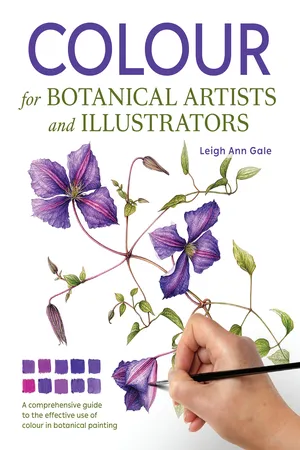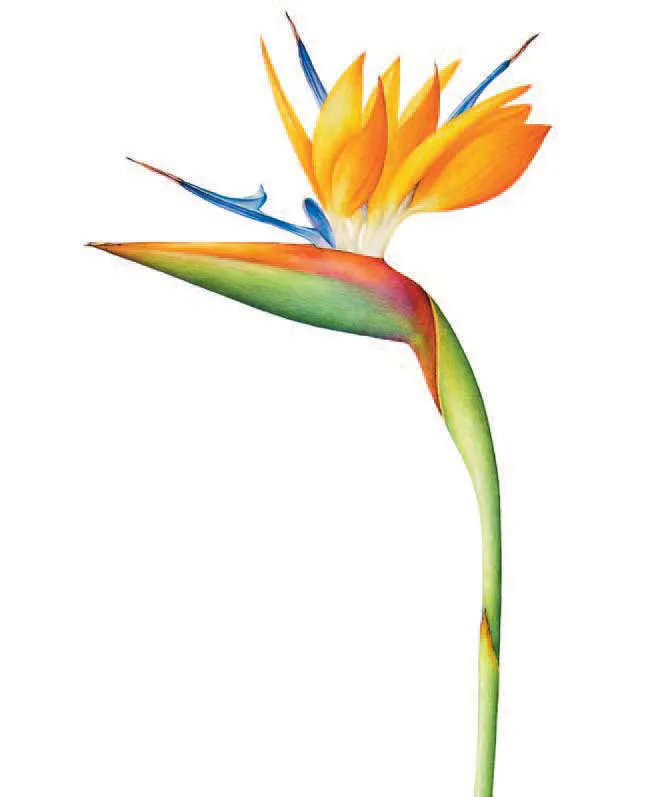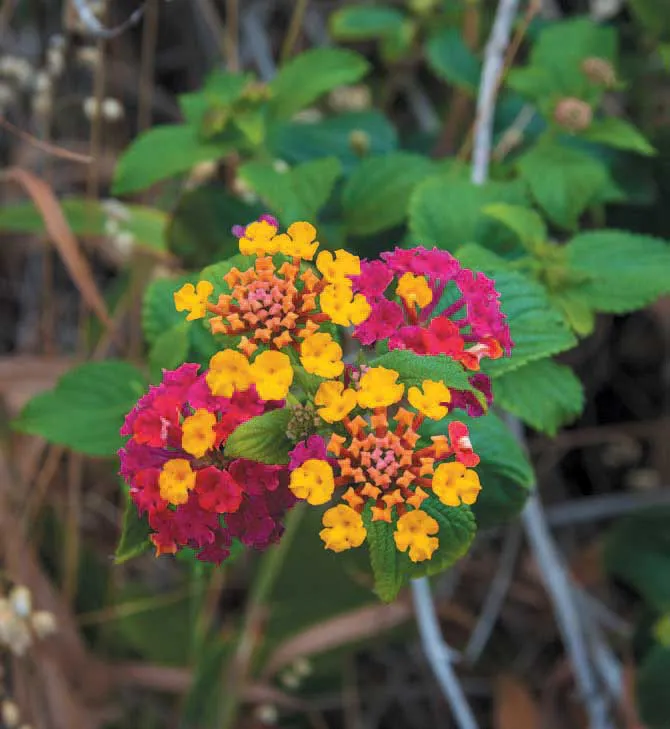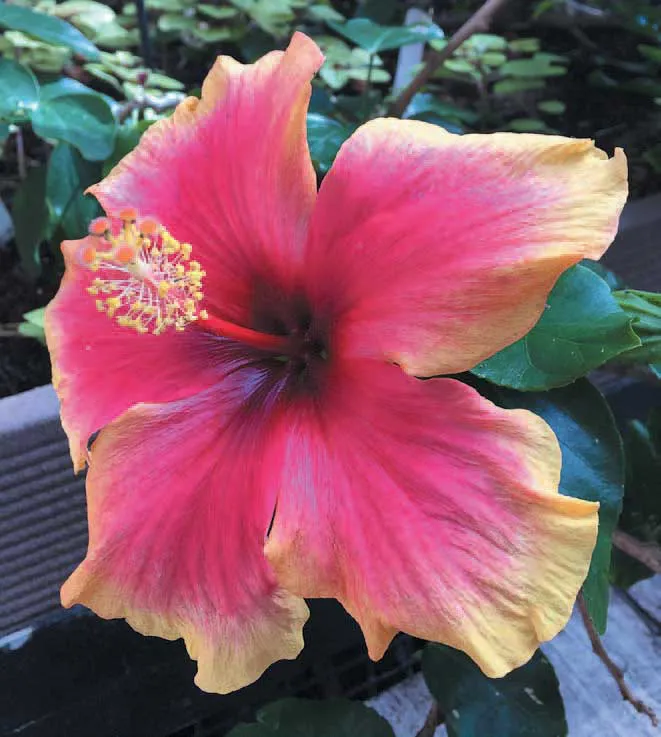
- 208 pages
- English
- ePUB (mobile friendly)
- Available on iOS & Android
eBook - ePub
Colour for Botanical Artists and Illustrators
About this book
This beautiful book explores the world of colour in the plant kingdom and introduces the artist to effective practical methods of using colour in botanical painting. It focusses on the relevance of making accurate observations of colour in botanical specimens and recognizing the value and importance of using colour theory to achieve successful results. With over 500 images, this elaborately-illustrated guide uses the author's finished artwork, diagrams, and step-by-step tutorials to explain the important role of colour in this compelling genre. This book is a must for all aspiring botanical artists, illustrators and students.
Frequently asked questions
Yes, you can cancel anytime from the Subscription tab in your account settings on the Perlego website. Your subscription will stay active until the end of your current billing period. Learn how to cancel your subscription.
At the moment all of our mobile-responsive ePub books are available to download via the app. Most of our PDFs are also available to download and we're working on making the final remaining ones downloadable now. Learn more here.
Perlego offers two plans: Essential and Complete
- Essential is ideal for learners and professionals who enjoy exploring a wide range of subjects. Access the Essential Library with 800,000+ trusted titles and best-sellers across business, personal growth, and the humanities. Includes unlimited reading time and Standard Read Aloud voice.
- Complete: Perfect for advanced learners and researchers needing full, unrestricted access. Unlock 1.4M+ books across hundreds of subjects, including academic and specialized titles. The Complete Plan also includes advanced features like Premium Read Aloud and Research Assistant.
We are an online textbook subscription service, where you can get access to an entire online library for less than the price of a single book per month. With over 1 million books across 1000+ topics, we’ve got you covered! Learn more here.
Look out for the read-aloud symbol on your next book to see if you can listen to it. The read-aloud tool reads text aloud for you, highlighting the text as it is being read. You can pause it, speed it up and slow it down. Learn more here.
Yes! You can use the Perlego app on both iOS or Android devices to read anytime, anywhere — even offline. Perfect for commutes or when you’re on the go.
Please note we cannot support devices running on iOS 13 and Android 7 or earlier. Learn more about using the app.
Please note we cannot support devices running on iOS 13 and Android 7 or earlier. Learn more about using the app.
Yes, you can access Colour for Botanical Artists and Illustrators by Leigh Ann Gale in PDF and/or ePUB format, as well as other popular books in Art & Art General. We have over one million books available in our catalogue for you to explore.
Information
CHAPTER 1
Colour in the Plant Kingdom
Throughout the world, flora (or plant life) exists in groups categorized usually by region. These regions – otherwise referred to as ‘floristic regions’ – are further categorized into distinct habitats that we are more commonly familiar with, such as tropical, temperate, forest, desert, etc. Among these rich, diverse habitats lie different groups of plants: those that may be indigenous to the region, known as native flora; species deliberately grown by man, which include agricultural and horticultural flora; and weed flora, those species considered undesirable or invasive.

Autumn Tints. (Leigh Ann Gale)
One of the most common visible features among all floral species is colour. Whether it is a humble buttercup growing on the roadside bearing its bright sunny yellow flower, or the most unusual of colours such as the turquoise blue of the exotic Jade Vine (Strongylodon macrobotrys) native to the tropical forest of the Philippines, virtually every species exhibits colour.

Buttercups are among many wild flowers bearing yellow flowers.

The Jade Vine (Strongylodon macrobotrys) exhibits an unusual turquoise colour.
Living plants bear colour pigmentation, the substances produced biologically resulting from selective colour absorption from light. For the botanical painter this means that the recognition of colour in flora is highly significant. Accurate colour matching and mixing of pigments must take place during the painting stage in the artist’s preferred medium to capture a true likeness of the colours of a species. Many plants contain the green pigment known as chlorophyll, which is the primary pigment in the floral kingdom, but other coloured pigments are produced among species that attract pollinating insects to flowers for the purpose of reproduction or to warn of danger, for example.

Strelitzia reginae. (Leigh Ann Gale)
The world of colour present in plants is vast. Colours from the entire colour spectrum exist among the whole plant kingdom, some more commonly than others, and some extremely infrequently. Here we will investigate this world of colour in flora, thinking about common and uncommon colour groups, the existence of ‘black’ and ‘white’ in nature, how colour alterations take place, and how and why some plants exhibit variegation and pattern. These considerations are all important to the botanical painter, who needs a fundamental understanding of colour in flora.
CREATING AN AWARENESS OF COLOUR IN FLORA
The production of a botanical painting involves many processes, from observational drawing at the very beginning, through composition, and finally painting. It is normal practice to consider the colours of your specimen early on, usually during the drawing process while observing living specimens. This is when the colours are at their best. The colours you see will be at their freshest and most authentic in natural daylight, as if the specimen were still attached to the plant. It is always advisable for botanical artists to mix and match these correct colours from the palette and add them as painted swatches into a sketchbook, alongside pencil drawings and observational studies, before any final painting takes place.

Practise mixing and matching colours to your botanical specimens and recording them alongside your drawings in a sketchbook.
Recording colours in specimens accurately is fundamental to the art of botanical painting, in very much the same way as using appropriate painting techniques is to complete a painting. Sometimes, however, this can easily be overlooked, perhaps through lack of skill, practice or patience, which can be to the detriment of the painting in the long run. Observation and recording of colour at the initial stages of a project will always ensure you have captured a true likeness to the colouration of your subject matter when ideally it will be at the peak of its growth. Similarly, it is understandable that students and amateurs may not necessarily notice subtle variations in hue on a leafy specimen of camellia, or the subtle changes in shades of yellow in a flag iris flower, for example, unless the colours are noted. With practice, however, these skills can be acquired and used later in the painting process.
WHY ARE PLANTS, FLOWERS AND FRUITS COLOURED?
A good majority of plants, at least in some part of their composition, are green – green leaves and green stems, for example – but many plants and flowers contain additional colour pigments, especially in the petals of flowers. Sometimes the leaves themselves may be the colourful part of a plant, perhaps displaying some variegation or patterning, or contrasting with small insignificant-looking flowers that may be less colourful. Additionally, we observe pigmentation in other structural components, such as the flower stems, bulbs and roots, as well as fruits and seeds, all of which may contain the same pigments as the flowers.
More often than not, it is the flowers themselves that are the most colourful structures of a species, primarily for reproductive purposes. Plants are static, they are unable to move around to seek out suitable pollinators and so they must do their utmost to attract them by other means. Attractive-coloured flowers are the solution, especially for those plants that rely on airborne insects and birds for pollination. These plants may also offer sweet nectar rewards, further enticing pollinators to visit and revisit them.

Colour distribution is evident in different structures of plants.

The tops and bottoms of gladioli corms exhibit colouration that may be indicative of forthcoming flower colours.

Lilium Bulbs. (Leigh Ann Gale)

The brightly coloured flowers of Lantana camera are attractive to pollinators.

Beautifully coloured hibiscus flowers are pollinated by insects and birds.

The heavy scented Philadelphus coronarius ‘Aureus’ is inviting to ...
Table of contents
- Cover
- Halftitle
- Title
- Copyright
- Contents
- Preface
- Introduction
- 1 Colour in the Plant Kingdom
- 2 What is Colour?
- 3 Watercolours
- 4 Colour Matching and Mixing
- 5 Using Colour Effectively in Botanical Painting
- 6 Specific Colour Challenges for Botanical Artists and Illustrators
- 7 Tutorials Through the Colour Spectrum
- Contributors
- Art Suppliers
- Acknowledgements
- Index